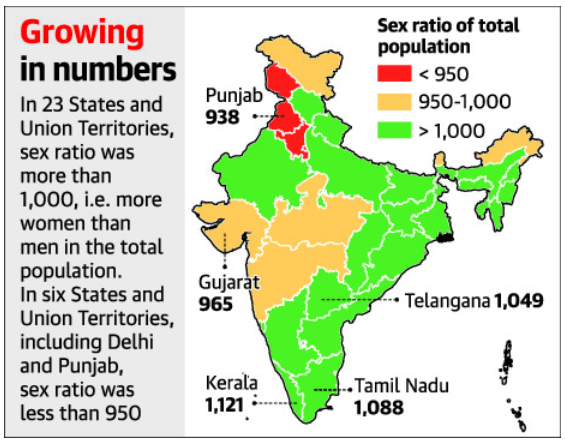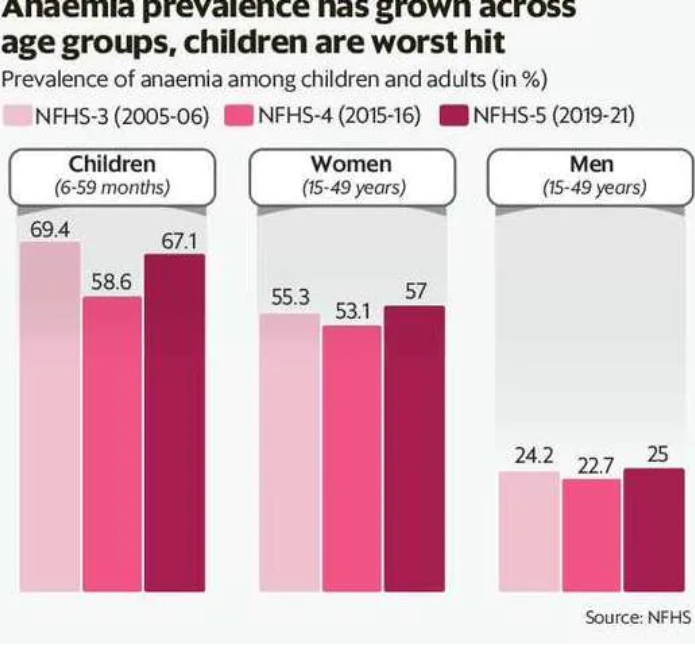ForumIAS announcing GS Foundation Program for UPSC CSE 2025-26 from 19 April. Click Here for more information.
ForumIAS Answer Writing Focus Group (AWFG) for Mains 2024 commencing from 24th June 2024. The Entrance Test for the program will be held on 28th April 2024 at 9 AM. To know more about the program visit: https://forumias.com/blog/awfg2024
Contents
- 1 Introduction
- 2 About the NFHS Survey
- 3 What is new in the NFHS-5, and what are the findings of Phase I?
- 4 What are the key findings of NFHS -5 Phase II at all India level?
- 5 What are the significant improvements observed from NFHS-5 Survey?
- 6 What are the concerns associated with the NFHS-5 report?
- 7 How India should improve further?
| For 7PM Editorial Archives click HERE → |
Introduction
The Ministry of Health and Family Welfare (MOHFW) has released the 2019-21 National Family Health Survey (NFHS-5) that belongs to phase-2 states along with all-India data. The Survey offers the status of key indicators such as population, reproductive and child health, family welfare, nutrition and others for India.
The findings of NFHS-5 with respect to 22 States & UTs covered in Phase-I were released in December 2020. Phase – II of the Survey covered the remaining 14 States/UTs. The NFHS-5 survey work has been conducted in around 6.1 lakh sample households from 707 districts (as of March 2017) of the country.
About the NFHS Survey
NFHS is released by the Ministry of Health and Family Welfare (MOHFW). But the MOHFW designated the International Institute for Population Sciences (IIPS), Mumbai, as the nodal agency. The IIPS is responsible for providing coordination and technical guidance for the survey.
5 rounds of National Family Health Surveys (NFHS) have been conducted so far in India. The first one was conducted in 1992-93. Every National Family Health Survey (NFHS) has two specific goals to fulfil. These are
- To provide essential data needed by the Ministry of Health and Family Welfare and other agencies for informed decision-making and policy and programme intervention purposes.
- To provide insight regarding important emerging health and family welfare issues.
What is new in the NFHS-5, and what are the findings of Phase I?
| Read here: National Family Health Survey (NFHS) – 5 |
What are the key findings of NFHS -5 Phase II at all India level?

The demographic shift in India: For the first time since the NFHS began in 1992, the proportion of women exceeded men. There were 1,020 women for 1,000 men. In the last edition of the survey in 2015-16, there were 991 women for every 1,000 men.
However, sex ratio at birth for children born in the past five years only improved from 919 per 1,000 males in 2015-16 to 929 per 1,000. This underscores that boys, on average, continued to have better odds of survival than girls.
Note: According to Census 2011 findings there are 940 females per 1,000 males.
Total Fertility Rates (TFR): Declined from 2.2 to 2.0 at the national level. Only six States — Bihar, Meghalaya, Manipur, Jharkhand and Uttar Pradesh — have a TFR above two. India is ageing faster than anticipated.
C-section deliveries: C-section births in India increased 4.3 percentage points over five years to 21.5% (NFHS-5) from 17.2% (NFHS-4, 2015-16). Nearly half the total C-section births (49.3%) took place at private health facilities in urban areas. Cesarean births decreased only in Nagaland and Mizoram.
Obesity: India has recorded a four per cent increase in obesity in both men and women in the last five years. No state recorded a decrease in percentage of both men and women who are overweight or obese. Some of the worst-performing states include Haryana, Karnataka, Manipur and Odisha.

Anaemia: More than half of the children and women (including pregnant women) are anaemic in all the phase-II States/UTs and all-India levels compared to NFHS4. 57% of women of reproductive age in the country are anaemic.
Assam is among the worst-performing states, with a huge spike in anaemic cases.
Women health: 11% of pregnant women are still either unreached by a skilled birth attendant or not accessing institutional facilities. The proportion of women (aged 15-24 years) who use menstrual hygiene products has increased by almost 20% points between 2015-16 and 2019-21 and currently stands at 77.3%. T
| Must Read: Union Health Ministry releases NFHS-5 Phase II Findings |
What are the significant improvements observed from NFHS-5 Survey?
Population: Achievement of TFR is a significant feat for the country’s family-planning programme and show India has contained the population explosion. But, the onus of family planning still lies with women. This is visible from an increase in female sterilisation and stagnated male sterilisation.
Further, India is still poised to be the most populous country in the world, with the current projection by the United Nations population division forecasting that India’s population will peak at 1.6 billion to 1.8 billion from 2040 to 2050.
The NFHS data also shows two key observations. 1. Urban-rural divide: with the TFR in the former at 1.6 against 2.1 in rural India, 2. North-south divide: Younger and male-dominated society in the north relative to the south and northeast.
Women gaining autonomy: In NFHS 4, 38.4% of women respondents reported owning a house/land alone or jointly, this has risen to 43.3% in NFHS-5.
Further, Women operating bank accounts increased from 53% to 79% between NFHS-4 and NFHS-5. Further, 54% of women have mobile phones against 46% earlier, and 77% used hygienic methods during menstruation against 57% earlier.
Bankers and researchers attribute the jump in bank account use to the role of the account opening drive carried out under the PM Jan Dhan Yojana over the last seven years.
| Read more: 7 years of PM Jan Dhan Yojana |
More accessible hospitals: Rise in institutional delivery signify that secondary healthcare systems – community and district hospitals – are accessible to more people. The data also reveal that most people are choosing private health facilities over public ones.
A much-needed data on lifestyle diseases: Having measured blood sugar and hypertension in the population for the first time, NFHS-5 highlighted the looming threat from lifestyle diseases.
Provide opportunity for states: State-level indices provide comparisons and allow States to launch course correction, or to be inspired by success stories in other regions.
What are the concerns associated with the NFHS-5 report?
Not reliable Demography data: Demography experts say the NFHS figures do not give an accurate picture of India’s sex ratio. They believe that the census figures were more reliable than NFHS. This is because:
1. Smaller sample sizes in the district when compared to Census, 2. Variation in sample sizes between states. For example, Andaman and Nicobar Islands gathered information from 2,624 households, whereas Assam gathered its information from 30,119 households, 3. The survey derived sex ratio based on the number of males and females present in the household on the last night of the survey, 4. NFHS counts only certain women, who belong to specific demographic categories, 5. The women’s questionnaire roughly has 1,140 questions and is 96 pages long, whereas the men’s questionnaire is 38 pages long with 843 questions, 6. Phase 2 of NFHS 5 happened during the Covid Pandemic, so migrant workers from Uttar Pradesh, Odisha, Rajasthan and Madhya Pradesh had returned to their home villages.
For all these reasons, the report itself advises “readers to be cautious while interpreting and comparing the trends as some states and Union territories”.
| Note: States such as Uttar Pradesh, Bihar, Odisha, Rajasthan and Madhya Pradesh have large and floating population. |
Electoral and economic implications: The north-south divide in terms of younger and older population might have worrying electoral and economic implications. For instance, the 15th Finance Commission used the States’ demographic performance as a criterion for devolution.
Women’s economic situation hasn’t improved a lot: Women who reported working in the past 12 months rose only marginally to 25.4% from 24.6% earlier.
Low performing food security and nutrition schemes: Health insurance coverage has reached merely 41% of households. Further, Rising figures of anaemic women and low improvement in children nutrition schemes highlights the low performance of the concerned schemes.
Increase in gender-related violence: The proportion of married women (between 18 and 49 years) who have been a victim of spousal violence has increased in five states. In Karnataka, it has jumped from 21% to 44%.
Women lag behind men in the literacy rate (71.5% against 84.4% for men). This is partly due to the number of years of schooling.
No data available for micronutrients: Lack of adequate nutrition is also measured by micronutrient deficiencies, i.e. lack of vitamins and minerals that are essential for body functions and needed for growth and development. While the NHFS does not have data on this.
How India should improve further?
Ramp up social infrastructure: India needs to quickly ramp up social infrastructure, including health, education, and water to reduce Anaemia and improve other services.
Focus on efficiency: Reach and coverage of sanitation related schemes has yielded better outcomes. But failure of the same to other schemes resulted in low performance. So, rather than making serial announcements of grand new schemes, focusing on maximising the efficiency of the ones the government already has should be the priority.
Population control measures: States should tackle the socio-economic issues confronting India rather than seeking neo-Malthusian approaches to population control. Further, India has to counter the deep-rooted son preference through policy and law.
Address the development deficit: The experience of the Southern states shows that declining fertility rates are not just the function of family planning programmes but also have direct links with empowering women. So, the Centre and other states have to work on empowering women.
Improve health services: Both Centre and State governments need to sustain their focus on public health and reduce out-of-pocket expenditure. Further, the pandemic has highlighted the need for building resilient and fortified systems capable of delivering in any circumstances.
Promote Indian diet: Indian diets display a rich diversity. Many traditional diets reflect both local climatic conditions as well as a multiplicity of sources of essential nutrients, such as proteins. So the government has to create awareness campaigns to promote Indian diet.
Check unethical practices of private health providers: Nearly half the total C-section births (49.3%) took place at private health facilities in urban areas. These figures are highly unnatural and call into question unethical practices of private health providers who prioritise monetary gain over women’s health and control over their bodies.
Empowering women and ensuring gender justice: It is imperative to address harmful practices, such as child marriage and gender-biased sex selection. One in three women continues to face violence from their spouse. Hence, there is a need to enhance the value of women and girls by working on transforming unequal power relations, structural inequalities and discriminatory norms, attitudes and behaviours.
Devising targeted strategies: The pace of progress between one NFHS and the next should be accelerated by devising targeted strategies based on specific indicators and regions that are currently lagging. Along with that, a convergence among multiple stakeholders is also essential.
In conclusion, States need to treat the NFHS as a resource and recognise it as a matrix to work on, to improve the development indicators further. Meanwhile, the Centre must not treat NFHS as a mere stocktaking exercise, but to harness the opportunities for launching reform or re-assessing certain policies without using NFHS as a political tool in a federal set up. So the action plan to improve India’s health needs to be inclusive, firm in its commitment and backed by solid resources.




